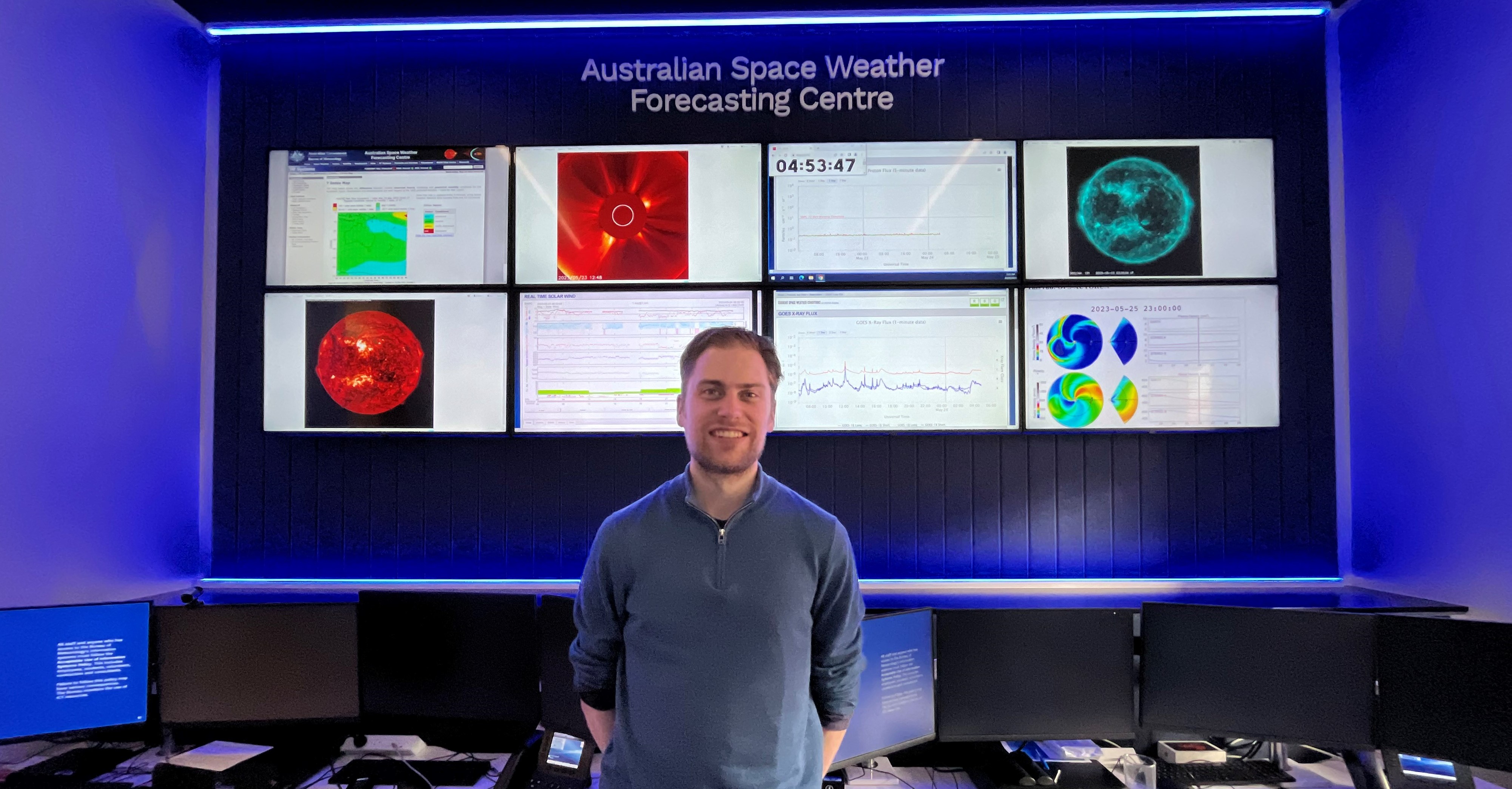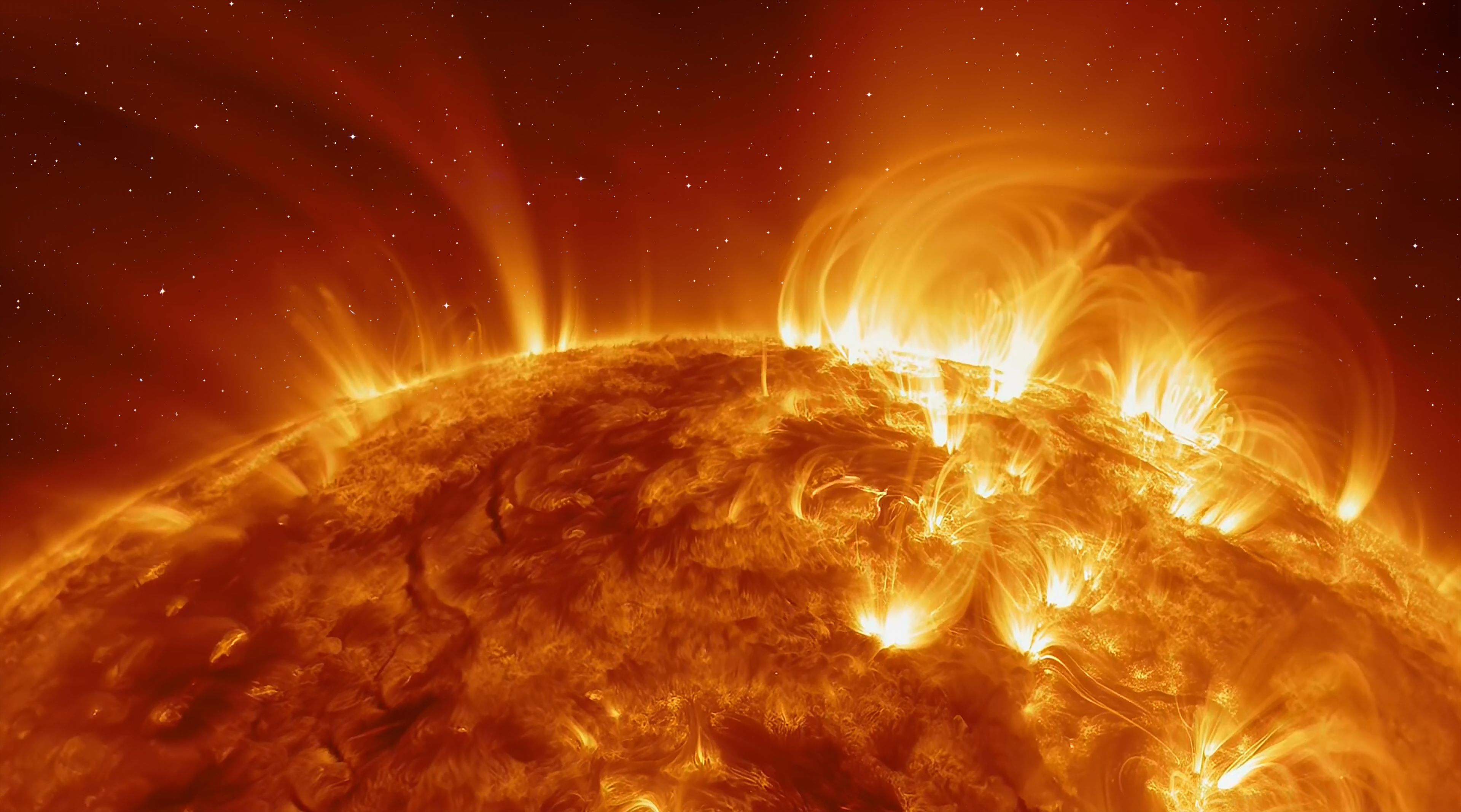Eyes in the sky: space weather forecasting

Andrew’s work includes keeping an eye on solar flares, geomagnetic activity, measuring the ionosphere, and plenty more beyond the clouds.
In summary
- Swinburne alum Andrew Jackling works for the Bureau of Meteorology at the Australian Space Weather Forecasting Centre in Adelaide
- Space weather forecasts are formed from imagery and data from satellites, and a myriad of other scientific instruments
- Part of the work is preparing for a one-in-a-hundred year space weather event, which may cause unforeseen damage to today’s technological world
For most of us, checking our weather app to see if the Sun will be out is ingrained into our daily routine. But aside from providing us with warmth and light, the Sun is responsible for a less well-known type of weather – space weather.
Swinburne alum Andrew Jackling works for the Bureau of Meteorology at the Australian Space Weather Forecasting Centre in Adelaide.
Instead of determining if there is a sunny or rainy day ahead, Andrew’s work includes keeping an eye on events such as solar flares or coronal mass ejections, which can impact critical infrastructure on Earth such as our energy grid, communications, and the economy more broadly.
Andrew was always interested in his field of work, studying astronomy, and majoring in astrophysics at an undergraduate level. In 2017, he completed his Master of Science (Astronomy) at Swinburne. However, his journey with Swinburne began much earlier.
For his high school work experience in year 10, Andrew had the chance to work at the Centre for Astrophysics and Supercomputing at Swinburne. There, he met Professor Duncan Forbes, whom he credits for providing him with that important introduction to astrophysics.
“I’ve got a lot to thank him for in terms of my journey. Duncan set me up to work with various astrophysicists and got me experience in the field which helped enormously.”
How the forecasting works
Space weather is monitored using numerous data sets and imagery from satellites. The space centre uses imagery from the Solar Dynamics Observatory (SDO), Solar and Heliospheric Observatory (SOHO) and GOES satellites. The Learmonth Solar Observatory also provides important imagery of the Sun in certain wavelengths.
Beyond imagery, there is a myriad of ground-based instruments that are used to measure the impacts of space weather events. For example, a magnetometer network measures geomagnetic disturbances, while the ionosonde network measures ionospheric variations where Earth’s atmosphere meets space.
“That’s just scratching the surface. There’s a lot of other instruments, particularly in Antarctica, we use to gather data. A little bit here, there, and everywhere,” says Andrew.
There are three categories for space weather – R, G and S, as outlined in the Australian Space Weather Alert System. The categories detail radio blackouts (caused by solar flares), geomagnetic storms and solar radiation storms, respectively. Each space weather event also has scales from 0 to 5 – with 5 being the strongest events.
Tracking all this data assists in forming the three-day space weather forecast, which can be accessed online.
On shift for forecasting
The Australian Space Weather Forecasting Centre has four space weather forecasters, and their shifts rotate each day.
“There’s usually only ever one space weather forecaster on shift, so it’s all on you, your analysis is what counts.”
Andrew would begin his shift analysing the last 24 hours of space weather and building a report.
Equipped with eight monitors, he can easily observe any changes in the data that could impact the forecast.
At a minimum for the rest of the day, he would monitor the space weather, issue warnings and respond to any customer enquiries for his eleven-and-a-half-hour shift.
The centre runs 24/7, so forecasters are always on call to analyse any events.

Powerful solar flares have the potential to create global transmission problems and world-wide blackouts
Better safe than sorry
In 1859, the world experienced its greatest solar storm, named ‘The Carrington Event’. An impressive solar flare and subsequent coronal mass ejection caused an unprecedented geomagnetic storm, with telegraph systems going haywire and auroral displays visible in the tropics.
In 1989, the entire province of Quebec suffered an electrical blackout caused by a solar storm.
Though these events are rare, Andrew highlights that these powerful space weather events could have extreme consequences for today’s world.
“We haven’t seen a Carrington-scale space weather event in today’s modern interconnected society, where technology is so heavily relied upon. What we are doing is ensuring that Australia is best prepared as it can be for that one-in-a-hundred-year event.”
“Making sure our main customers in defence, energy operators and aviation are adequately informed, puts Australia in the best position to respond to an event like that.”
-
Media Enquiries
Related articles
-

- Technology
- Aviation
- Sustainability
Swinburne partners with Latrobe City Council to propel Victoria’s Advanced Air Mobility precinct
Swinburne has become the first Foundation Member of the newly established Latrobe Aerospace Technology Precinct.
Friday 03 May 2024 -

- Technology
- University
Swinburne-founded software startup Fluency launches first product suite
Fluency, a startup co-founded by a Swinburne alum, is launching its first product suite aimed at streamlining manual documentation processes.
Friday 10 May 2024 -

- Technology
- Health
MChart redefines mental health service planning through cutting-edge data analytics
MChart, a new tool under development by Swinburne University of Technology and University of Canberra researchers, is set to help health care providers navigate the complexities of mental health service planning using data analytics and geospatial mapping.
Monday 13 May 2024 -

- Astronomy
- Science
Swinburne appoints new Director of Innovative Planet Research Institute
Leading geodesy expert, Professor Allison Kealy, has been appointed as the inaugural Director of Swinburne University's Innovative Planet Research Institute.
Monday 22 April 2024 -

- Astronomy
- University
OzGrav 2.0: A ‘new era of astrophysics’ launched at Swinburne
The next phase in the world-leading ARC Centre of Excellence for Gravitational Wave Discovery, dubbed 'OzGrav 2.0', launched this week at Swinburne University of Technology.
Wednesday 17 April 2024

